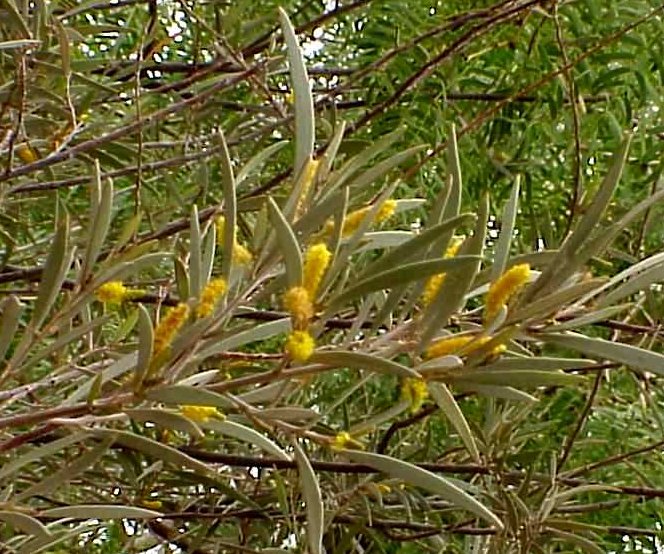


Acacia aneura
Mulga
Foliage: Evergreen
Mature Height: 14’ - 18’
Mature Width: 12’ - 16’
Growth Rate: Moderate to Fast
Hardiness: 15 degrees F
Exposure: Full Sun
Leaf Color: Silver-Gray
Shade: Filtered
Flower Color: Sulfur-Yellow
Flower Shape: Rod Shape
Flower Season: Spring
Thorns: None
Propagation Method: Seed
Sizes Available: #24, #45


Acacia aneura (Mulga) In a landscape palette with a limited number of evergreen trees, Acacia aneura is a welcome addition to desert landscapes. Acacia aneura is native to all mainland states of Australia, where it grows in low rainfall areas and in most soils, including clay. The common name, Mulga" is an Australian Aboriginal word that means dream seed, both the tree and it’s seed are part of their mythology. The tree has a moderate growth rate with a mature height of 14’ to 18’. It grows well in a variety of settings but prefers full sun and well draining soils. The densely arranged needle-like, silver -gray phyllodes (leaves) give the canopy an airy, lacy quality that contrasts with the dark reddish brown branches. The canopy can extend to the ground. Typically bottom branches are trimmed to expose the trunk(s) and give the tree an umbrella form.
Acacia aneura is unusual in that it has an open flowering cycle. The trees produce small, sulphur yellow, rod shaped flower about 3/4" long. Tan pods (1" to 1 1/2") mature from these flowers and are ultimately dropped. Once this flowering cycle is complete another one begins. Trees may produce 3 to 4 flower cycles per year with the heaviest flowering usually occurring in the spring or following summer rains. The bright yellow flowers in combination with the silver-gray leaves make Acacia aneura a striking accent tree in the landscape. It is also used as a hedge or screen planting and can be used in small groupings. Encouraging a more shrub-like growth habit, by reducing or eliminating pruning, is more desirable in hedge and shrub applications. Because trees are damaged by water saturated soils it is not recommended for planting in turf areas or with an under-story of high water demanding plants.
Reports indicate the Acacia aneura is hardy to about 15 degrees F. Our experience in Phoenix is that the trees survive normal winters. This Australian native has clearly found a home in the desert southwest.
Cultural Practices:
Foster the development of a more dispersed root system and reduce the risk of wind throw by arranging irrigation emitters at varying distances from the trunk to encourage roots to "seek out" water and nutrients. Irrigation emitter arrangement along with other information on irrigations practices for desert trees can be found at Irrigation Practices for Desert Trees.
Prune as needed to reinforce the structure and form of the tree. Periodic thinning is the most desirable method of pruning. Avoid hedging or heading back desert species, as this will only stimulate excessive branching. Do not remove more than 30% of the canopy during the summer as this can lead to sunburn injuries that can later be invaded by wood boring insects. Always use clean, sharp tools that are cleaned regularly in a 10% solution of bleach. For detail pruning guide see Pruning Desert Trees.
Acacia aneura is relatively free of serious insects pests.
Periodically insect pests can be a problem on some desert trees. On young trees, insect infestation can slow typical seasonal growth. Inspect trees during the growing season for common garden sucking insects such as aphids, thrip, whiteflies or psyllids. During dry months, (May and June) in dusty conditions, spider mites can appear. Monitor for infestation and apply controls as needed. Spray applications of water or water and Safer Soap give short-term control (3 to 7 days) for small insect population. For heavy infestation or longer control use federally registered insecticides. A contact insecticide application will kill existing adults. An application with a systemic soil drench will provide 8 to 12 weeks control for any post application insect hatchings or migration of insects. Before using pesticide for the first time or on new plants or cultivar, treat a few plants and check for phytotoxicty. Always read label and follow label instruction before using pesticides. For pesticide control recommendations contact a licensed pest control advisor.

© Copyright 2000-2020 Arid Zone Trees